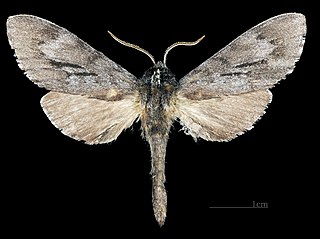
Lapara coniferarum, the southern pine sphinx, is a species of sphinx moth. It was first described by James Edward Smith in 1797. The species is listed as threatened in Connecticut.

Rosa palustris, the swamp rose, is a shrub in the rose family native to much of eastern North America. It can be found from Nova Scotia and New Brunswick in the north, south to Florida and west to Arkansas and Ontario. It is a host of the blinded sphinx moth and Coptotriche admirabilis.
Palustris is a Latin word meaning "swampy" or "marshy", and may refer to:

Hypenodes is a genus of moths of the family Erebidae erected by Henry Doubleday in 1850.

Thelypteris palustris, the marsh fern, or eastern marsh fern, is a fern native to eastern North America and across Eurasia. It prefers to grow in marshy situations in full sun. The species epithet palustris is Latin for "of the marsh" and indicates its common habitat. It is the only known host plant for Fagitana littera, the Marsh Fern Moth.

Mesothea is a monotypic moth genus in the family Geometridae described by Warren in 1901. Its only species, Mesothea incertata, the day emerald or plain emerald, was first described by Walker in 1863. It is found in North America.

Hypenodes humidalis, the marsh oblique-barred, is a moth in the family Erebidae. The species was first described by Henry Doubleday in 1850. It is found in most of Europe and across the Palearctic to Siberia.
Hypenodes anatolica is a species of moth in the family Erebidae. It was described by Leo Schwingenschuss in 1938. It is found in Bulgaria, Greece, North Macedonia and Turkey.
Hypenodes caducus, the large hypenodes moth, is a species of moth in the family Erebidae. It was described by Harrison Gray Dyar Jr. in 1907. It is found in North America, including British Columbia, Maryland, Massachusetts, Michigan, Minnesota, New York, Ohio, Ontario, Quebec, South Carolina and Wisconsin.
Hypenodes fractilinea, the broken-line hypenodes, is a moth in the family Erebidae. The species was described by John B. Smith in 1908. It is found from Nova Scotia south to North Carolina, west across Canada to Alberta. The habitat consists of mixed wood and deciduous woodland.
Hypenodes franclemonti is a species of moth in the family Erebidae. It was described by Douglas C. Ferguson in 1954. It is found in North America, including Florida, Michigan, Minnesota, Missouri, Pennsylvania and Quebec.
Hypenodes kalchbergi is a species of moth in the family Erebidae. It was described by Staudinger in 1876. It is found in Slovenia, the former Yugoslavia and on Sicily.
Hypenodes sombrus is a species of moth in the family Erebidae. It was described by Douglas C. Ferguson in 1954. It is found in Canada from Nova Scotia to western Alberta. The habitat consists of bogs, cattail marshes, dry pine and other woodlands.
Apantesis carlotta, or Carlotta's tiger moth, is a moth of the family Erebidae. It was described by Douglas C. Ferguson in 1985. It is found in the US from Maine to Georgia, west to North Dakota and Texas.
Neoarctia lafontainei is a moth of the family Erebidae. It was described by Douglas C. Ferguson in 1995. It is found in Canada's Northwest Territories.
Digrammia sexpunctata, the six-spotted digrammia, is a moth in the family Geometridae described by J. Elwyn Bates in 1886. It is found in North America.

Dysstroma ochrofuscaria is a moth in the family Geometridae described by Douglas C. Ferguson in 1983. It is found in North America.
Digrammia pallorata is a species of moth in the family Geometridae. It was described by Douglas C. Ferguson in 2008 and is found in North America, where it has been recorded from Utah, Colorado, Nevada, Texas, New Mexico, Arizona and California.
Speranza austrinata is a species of geometrid moth in the family Geometridae. It was described by Douglas C. Ferguson in 2008 and is found in Central and North America.

Synchlora frondaria, the southern emerald, is a species of emerald moth in the family Geometridae. It is found in the Caribbean, Central America, North America, and South America.






